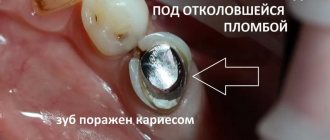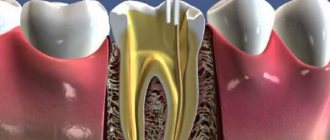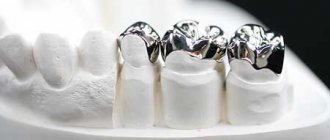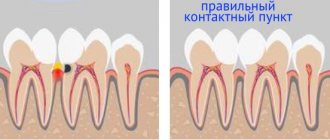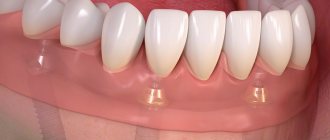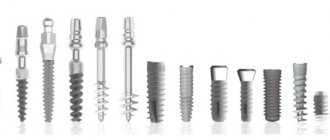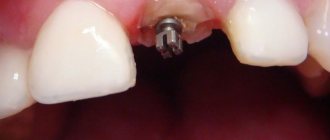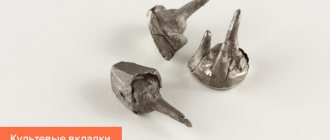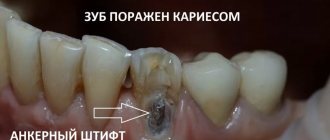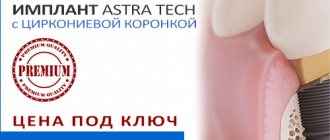Tooth decay has not been a problem for dentists for a long time. In this case, it is not necessary to remove the root and place an implant. If the tooth is at least partially preserved, it can be restored using a pin. This design allows you to grow a new tooth or install a crown, while returning it to its original functionality and appearance. Pin technology is not complicated and quite reliable, so it is often used to solve dental problems.
Types of pin teeth
Today in dentistry several types of tooth post structures are used, differing in their shape and material. Here are the main ones:
- Standard. This pin is made in the shape of a cone or cylinder and is used for minor tooth decay.
- Individual. It is made based on the patient’s photograph, taking into account the characteristics of the relief of the tooth root.
- Metal. For reliability and strength, the rods are made of titanium. This allows you to strengthen the artificial part of the tooth.
- Fiberglass. It is an excellent replacement for its metal counterpart. It is elastic, does not show through the filling and does not react to saliva.
- Anchor. The main alloy for the pin is titanium-based alloy. These rods are considered one of the best today.
- Carbon fiber. This type of rod is considered one of the most modern in dentistry. Its advantages include strength, reliability and uniform load distribution in the root canal.
In what cases is it permitted and prohibited to install a pin?
A tooth destroyed by caries or mechanical damage does not always require the installation of a pin. In some cases, restoration measures are sufficient, especially when it comes to the front teeth. To restore a tooth using pin technology, there must be certain strict indications, which include:
- destruction of the crown part of the tooth by more than 50%;
- the need for support for removable and fixed dentures;
- absence of the outer part of the tooth with complete preservation of the root;
- stopping subsequent tooth decay after treatment of serious carious lesions;
- tooth restoration after surgical treatment of periodontal pathologies;
- saving a tooth after treatment for infectious diseases of the oral cavity.
The pin is installed only if the tooth walls are preserved by at least 15-20% and the root thickness is at least 2 mm. If for some reason this is not possible, then an alternative recovery method is selected.
The use of a pin for dental prosthetics also has its contraindications. These include:
- serious untreated carious damage to the walls of the tooth;
- damaged or very thin tooth roots;
- impossibility of clearing dental canals to at least 1/3 of the depth;
- insufficient root canal height;
- granuloma and cyst of the jaw in the acute period;
- chronic periodontal pathologies;
- problems with blood clotting;
- pregnancy period;
- neuropsychiatric diseases;
- history of allergic reactions to implants.
Only taking into account all the indications and contraindications is it possible to choose the right technology for treating a decayed tooth. Installing a pin involves certain restrictions that cannot be ignored by either the patient or the doctor.
Types of pin structures
The pin itself, together with the crown on it, is called the gingival structure. The classification according to the method of fastening the knitting needles is as follows:
- The active method of attachment requires the presence of sufficiently narrow and healthy gum canals. A thread is applied to the base of the pin; when installed in a tooth, it is screwed inward. This method allows you to firmly and reliably fix the insert rod in the tooth, provides reliable support for any crown, and is intended for metal pins.
- The passive technique makes it possible to reliably place a rod made of any material and allows you to strengthen the wide canals of the dental unit. Dental cement is placed into the canal and a pin is lowered into it under pressure. With this pin design, it does not rust; the cement additionally seals the channels.
We suggest you familiarize yourself with Teeth Whitening if you have crowns. Is it possible to whiten crowns and teeth together?
Content:
- Classification
- Materials from which pin structures are made
- When to place a pin
- Terms of use
- Installing a seal
- Advantages and disadvantages of the technique
If the crown of a tooth is very badly damaged and it is not possible to restore it with a regular filling, dentists often use dental pins. These are affordable elements that allow you to recreate a semblance of the original structure of the damaged unit. Visually, they resemble a cone-shaped pin of short length, which is easily fixed in the coronal part of a molar, canine and even incisor. Pinned teeth look quite aesthetically pleasing and, if the work is done well, are practically no different from their healthy neighbors. However, they are not as durable as, for example, dentures or implants. Most often, their service life is limited to three to five years, after which restoration work must be carried out again.
Materials for making pins
Materials for pins in dentistry must be physiologically neutral for body tissues, not subject to destruction in the oral cavity, not rust, not oxidize, and withstand physical stress. Each rod must have high abrasive properties - high abrasion resistance, because being inside, it will be subject to constant compression when exposed to the restored tooth.
Fracture strength is another necessary feature of pin structures, so the material must be not only durable, but also flexible. When chewing food, the knitting needle is subjected to angular loads, which requires it to bend but not break.
Scope of application of pins
Scope of use of structures:
- Crown support . If the crown is severely damaged, the tooth is not able to perform its functions fully. The orthopedic design involves the installation of a pin, which returns the previous capabilities and a snow-white smile.
- Support for a bridge . The pins make it possible to install a dental bridge even if the supporting crowns are completely destroyed. The structures are installed in the treated canals and provide reliable fixation for the prosthesis.
- Support for the seal . A partially or almost completely destroyed crown is not yet a reason for tooth extraction. The doctor determines whether, by installing a pin, it is possible to form an artificial crown, which will take over the functions of the destroyed tissue when a composite composition is applied.
Scope of application of structures. Source: Google
Pin tooth. Source: YouTube channel Vsyaimplantatsiya.rf
Metal
For pins, it is justified to use metals not in pure form, but in the composition of metal alloys, due to the precise selection of the composition of which the required properties can be fully achieved. They use steel, gold, brass, titanium, palladium.
Due to its color, the metal rod is visible and shines through through plastic crowns, and therefore is not aesthetically pleasing. Metal can rust and deteriorate, thereby creating a favorable environment in the dental pulp for the development of microorganisms and caries. This type of pin has high strength and is excellent for restoring chewing units.
Titanium alloy is the most durable material for pin structures. It almost never causes allergic reactions, is not subject to destruction, is perfectly compatible with dental and periodontal tissues, and takes root well. Titanium pinning is done even if the unit is completely lost along with the root part; titanium pins are inserted as gum implants.
We invite you to familiarize yourself with What is sodium lauryl sulfate?
Installing a seal
If most of the unit remains in good condition, it is restored according to the following scheme:
- Carrying out X-ray diagnostics. Using the image, the doctor examines the degree of tortuosity and depth of the canals, their condition, and determines whether it will be possible to fix the element.
- Sanitation of the oral cavity. All carious areas are treated. If pulpitis, gingivitis or any other dental disease is diagnosed, it is treated.
- Preparing the roots. The pulp is removed, the roots are cleaned mechanically, and then washed with an antiseptic. The channels are given the required shape.
- Installation of an artificial rod. It is fixed with heavy-duty cement.
- Extension of the coronal part. When the cement hardens, a photopolymer composite is applied layer by layer to the protruding part of the support.
Immediately after restoration procedures, the patient goes home.
Parapulpal
Parapulpal pins strengthen the remains of the root and crown if living pulp is preserved. They are made from metal alloys of brass, gold, steel, titanium and look like thin needles. There may be a thread at their lower end. The fundamental difference from anchor ones is that they have the same thickness throughout the entire length of the rod and do not replenish the total volume of the tooth, that is, the unit itself must maintain a wall level sufficient for restoration.
Before installing parapulp wires, the canals are cleaned with a bur from remnants of dentin and nerves, washed, and the rods are installed without affecting the core of the tooth - the pulp. The number of spokes is equal to the number of tooth corners to be restored, for chewing units - the number of apical cusps. The tooth and post are then covered with a filling and a crown.
It is not recommended to insert parapulp wires into the gums in cases of extension of pulpless teeth. Hollow units are more fragile and require filling, for which anchor pins are better suited.
Types and types of dental pins
The pin is not a stable structure; it is selected to suit the individual needs of each patient. For this purpose, different types of pins have been developed, which are indicated for a particular pathology. First of all, there are several materials for making a dental rod. Depending on this, pins are divided into two types - metal and non-metal.
- The metal pin is made of metal alloys. Titanium, brass, gold, steel, palladium are used. It is difficult to find a pure gold or titanium pin, and it will be expensive. Most often there are compounds in which one or another metal predominates. The choice usually depends on the purpose of the pin, as well as the individual body's reaction to the material. All metals are inherently hypoallergenic, but cases of hypersensitivity do occur. For severe allergies, a pin with gold impurities is perfect. In case of significant tooth damage, it is better to take titanium - the strongest and most durable material that can withstand heavy loads. But it is not plastic, so it can damage the root under strong pressure. You need to inform your dentist about all your peculiarities in order to adequately select the material and then not redo the tooth.
- Non-metallic pins involve the use of carbon fiber, ceramics, and fiberglass. Carbon fiber is a very plastic material, but is rarely used in dental practice due to its low strength. And the pin should serve as the main holder of the artificial tooth.
- Ceramic knitting needles in the tooth are very aesthetic. They do not show through the crown and are not visible even upon close examination. At the same time, ceramics cannot boast of strength and wear resistance. It is advisable to use a ceramic pin on teeth that are visible when smiling and are slightly involved in the chewing process.
- The best option according to all criteria is fiberglass. This material is plastic, flexible, lightweight and completely transparent. Under heavy load, such a pin bends and then returns to its original state without damaging the walls and root of the tooth. Externally, the design is absolutely invisible, so it is suitable for any teeth.
Non-metallic structures are used by dentists much less often than metal ones, mainly due to the high cost of prosthetics.
The method of attaching and fixing the pin in the jaw plays an important role. There are two main types of pins:
- active;
- passive.
The active design implies the presence of grooves (like the threads of a bolt), thanks to which it is screwed into the bone tissue. This ensures maximum reliability and immobility. This restoration method is suitable for non-expanded dental canals. When properly installed and secured, the active pin lasts for decades without moving or breaking.
Passive pins are used less frequently and are indicated for the treatment of severely damaged teeth. A large hole in the tooth will not hold an active structure, so a passive one is used. It involves filling the cavity with cement into which a pin is inserted. Installation is simple and quick, but less reliable and durable.
The appearance and shape of the dental post also varies. The most popular and popular conical and cylindrical designs, which are considered standard. But in different situations it may be necessary to select a more exclusive form. For such a case, cylindrical and screw pins were invented. The choice depends on the characteristics of the channel and the size of the hole.
A separate group includes individual pins, which are made in a single copy for a specific person. Such a knitting needle exactly follows all the bends and expansions of the dental canal, ensuring reliable fastening of the crown.
Approximate prices
How much does it cost to install a tooth on a pin? The answer to this question depends, first of all, on the type of structure, on the material used, on the degree of preservation of the tooth and on the amount of work required for its restoration. The average cost of teeth on pins in Moscow clinics is as follows:
- anchor (usually titanium) pin in a tooth - from 500 rubles. ($7.5);
- fiberglass - from 2000 rub. ($31);
- stump inlay - from 10 thousand ($153) (cobalt-chromium alloy) to 27,000 ($415) (ceramics).
We invite you to familiarize yourself with the tonsils and why they are needed. Why do humans need tonsils?
The price indicated is for the pin only; the cost of tooth restoration performed using it will be different: on average from 3,000 ($46) to 15,000 rubles ($230). In addition, to this amount it is necessary to add the cost of making a crown or building teeth with composites - from 3 to 20 thousand rubles ($46-307).
What are the advantages and disadvantages of pins?
To make the optimal choice of orthodontic design, you must weigh all the pros and cons of installing a pin in the tooth. After all, you will have to live with this for many years, preferably without discomfort and all sorts of complications.
A tooth that is more than half destroyed cannot be restored or filled, especially if it is chewable. In this case, the only way out is complete removal and placement of the implant. But dentistry has come up with an ideal alternative to both operations - a pin tooth. It is less painful, less time-consuming and much more economical. This is the main advantage of the pin.
But this is not all the advantages. In addition to saving a hopeless tooth, pins:
- do not damage or violate the integrity of neighboring teeth;
- suitable for installation anywhere in the dentition;
- allow you to restore a damaged tooth almost from scratch, returning it to its original appearance;
- have a long service life - from 10 to 20 years;
- are made from different materials, which allows you to choose for each individual case;
- withstand heavy loads when chewing food;
- completely restore the functionality of a damaged tooth.
Like any dental structure, pins have some disadvantages. After constant significant loads, they can gradually destroy the tooth root and crown, which will ultimately lead to its complete removal. The inelasticity of some materials contributes to this. Sometimes caries develops around the knitting needle, which cannot be seen during examination. This situation is excluded if the installation was carried out efficiently and professionally.
Very rarely, a pin can cause an allergic reaction followed by rejection. In this case, you will have to remove it and replace it with another material or install an implant. And, of course, the price for installing a pin is not small, so you need to be prepared for significant expenses. Although, a beautiful smile and lack of discomfort are worth it.
In any case, the advantages of the pins are much greater than the disadvantages. And the selection of a tooth restoration method remains up to the doctor. In most cases, it all depends on the specific situation and the severity of the tooth problem. Trust professionals who know what is best for your teeth.
previous post
Important recommendations after tooth extraction: food, drink, alcohol, smoking
next post
Rehabilitation
Despite the fact that the operation of restoring a tooth with a pin is considered ordinary in modern dentistry, it has a postoperative period, during which it is necessary to follow the rules:
- take medications prescribed by your doctor (for example, antibiotics);
- do not injure the mucous membrane with food, consume it in a pureed state;
- brush your teeth at least twice a day, but very carefully, with a soft brush, to avoid injury;
- do not use toothpicks, especially in the area where restoration was carried out.
Stump inlay with a pin in the arsenal of dentists at the ALTEYDENT clinic
Despite the growing popularity of direct restoration with composite materials using build-up technology, it cannot be used:
- After repeated treatment using a resorcinol-formalin mixture, since the degree of adhesion of epoxy resins to the walls in this case decreases sharply.
- With a large volume of cavities after mechanical treatment of dentin, which leads to significant shrinkage of glass composites.
- When the crown is completely lost, or its borders are at least partially under the gum.
In all these situations, we strongly recommend that patients install a stump pin insert. This method of restoration is optimal for the loss of one tooth bordering on vital “neighbors.” The limitation for working with inlays is the violation of the integrity of the roots, which leads to the need for removal and subsequent implantation.
Our laboratory allows us to work at a high technical level using two technologies: model casting of chrome-cobalt inlays and CAD/CAM production methods from zirconium dioxide. The cost of metal cast stump pin inlays is RUB 3,000 . The price of a pin stump inlay made of zirconium dioxide is 8,000 rubles . Additional costs for inlay placement are related to the cost of pretreatment and the type of cement used.


